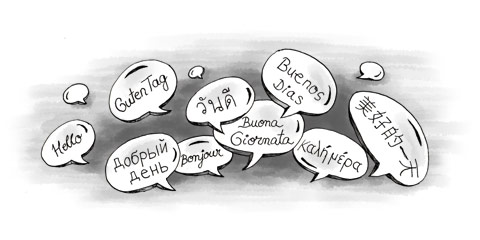The island nation of Sri Lanka is home to many ethnicities - Moors/Muslims, Burghers/Eurasians, Veddahs, Malays, Sinhalese and Tamil - which adds to the dynamics of the languages spoken. Not only that, but Sri Lanka’s languages are influenced by the neighboring countries of India, the Maldives and Malaysia; plus the Arab settlers, and the colonial powers of Portugal, the Netherlands and Britain have had significant influences in the development of Sri Lanka’s languages.
Two official languages
Both Sinhala and Tamil are the official and national languages of Sri Lanka. Although the two have different derivations, they share some characteristics, have loanwords from each other and influence each other’s linguistic evolution.
Sinhala: සිංහල
Sinhala is the native language of the Sinhalese people, who constitute approximately 70 percent of Sri Lanka’s population, which equals about 13 million people. Sinhala is also spoken amongst other ethnic groups on the island as a second language, making it the most widely spoken language of Sri Lanka.
The oldest record of the Sinhala language dates back to the 6th century BCE in the form of inscriptions on pottery. It is believed to have been brought to Sri Lanka by colonists from northern India around the 5th century BCE. Modern Sinhala is thought to have developed in the 12th century CE.
Sinhala belongs to the Indo-Aryan branch of the Indo-European languages, but due to its isolation from the other Indo-Aryan languages of mainland India, the language developed quite independently. It was greatly influenced by Pāli, the sacred language of the Sri Lankan Buddhists, and after centuries of colonial rule in Sri Lanka, Sinhala contains many Portuguese, Dutch and English loanwords. Sinhala also has a number of words borrowed from Tamil.
Tamil: தமிழ்
Tamil is Sri Lanka’s other official language, spoken by about five million people in Sri Lanka, which is about 15 percent of the population. Tamil is also an official language of Singapore and spoken amongst minority groups in Malaysia, Mauritius, Australia, South Africa, Canada and the USA.
Tamil belongs to the Dravidian language family, which consists of approximately 85 languages spoken by around 217 million people, predominantly in India, particularly the southern Indian state of Tamil Nadu, where it is the first language of the people, Pakistan, Nepal, Bangladesh, Afghanistan, Iran, Malaysia and Singapore, apart from Sri Lanka.
The earliest known Tamil inscriptions are presumed to date back to at least 500 BCE. The actual age of the Tamil language cannot be calculated, but it is thought to be the oldest of the Dravidian languages. Furthermore, the origin, evolutionary story and development period of differentiation of Dravidian languages has provoked many theories and controversy amongst linguists and language research scholars.
Sri Lankan English (SLE)
Tamil and Sinhala are Sri Lanka’s two official languages, and English is known as the link language. Although the public has the right to deal with government institutions in any of the three languages, it is generally English that is preferred in governmental policies and practices.
English in Sri Lanka is known as Sri Lankan English (SLE) and has quite a few differences from British English and that which is spoken in America. For example, the use of particular tenses and the posing of questions with a different intonation. Certain nouns are added in SLE vocabulary which don’t exist or have no significant meaning outside of Sri Lanka, and the use of certain words that most speakers of modern-day English would consider outdated. Pronunciation also differs, as there are certain sounds that many speakers of SLE are incapable of producing.
Although English has been used in Sri Lanka since the time of the British Empire, around the 16th century, Sri Lankan academicians debate about the legitimacy of SLE as a separate dialect.
Other languages in Sri Lanka
The Rodiya people of Sri Lanka speak a dialect of Sinhala called Rodiya. The Moor ethnic minority speak a form of Tamil which is influenced by Arabic. Sri Lankan Creole Malay, a unique language with both Tamil and Sinhala roots is still spoken by a minority of Sri Lankans. The small ethnic minority of the Veddah people speak a distinct language, which most likely has been creolized from an early indigenous language.

